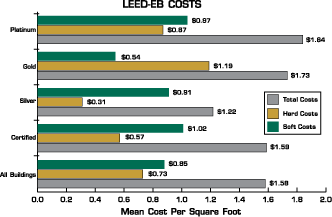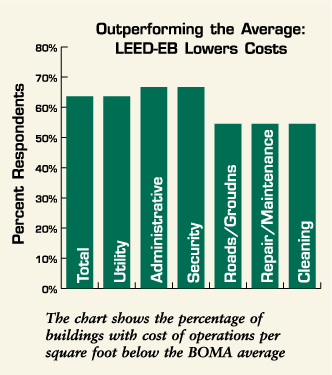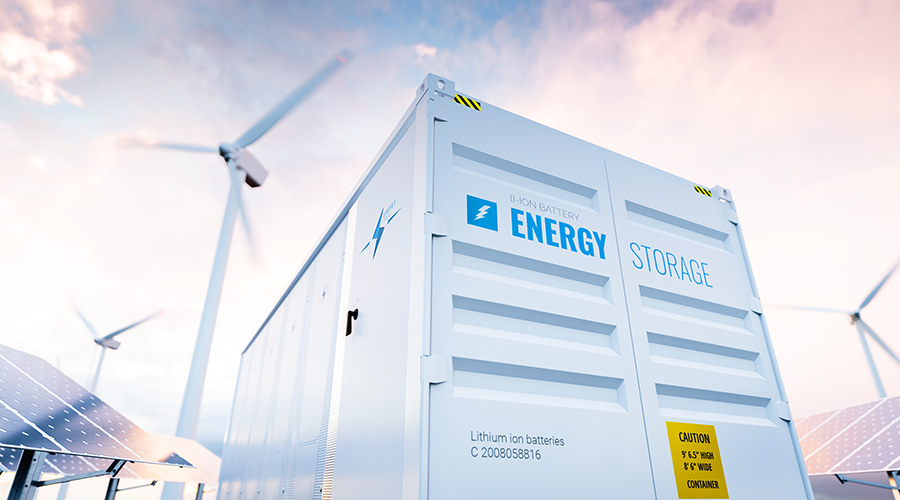LEED-EB Lowers Operating Costs, Report Finds
The LEED for Existing Buildings (LEED-EB) rating system has become an important benchmark of sustainable building operations and maintenance. As facility executives consider implementing LEED-EB certification for their buildings, what can they expect the cost of certification to be?
A recent survey shows that the cost of LEED-EB implementation may not be a barrier to beginning an organizationwide LEED-EB initiative. Not only is the cost of certification less than many facility executives may think, also operating costs for LEED certified buildings are on average lower than traditional buildings. Many low and no cost credits can serve as a starting point for facility executives to begin the journey to LEED-EB certification.
Of the 53 buildings LEED-EB certified under the pilot project or under v2.0 through 2007, responses were received for 23 buildings, a 43 percent response rate. Information was gathered in three areas: the cost of certification, the rating of the cost of each LEED-EB prerequisite or credit as low/no cost or significant cost, and the cost of building operation.
The soft and hard costs of LEED-EB certification were received from 13 buildings. Building size ranged from 20,000 to 1.6 million square feet with a mean of 359,667 square feet. Soft costs included the USGBC LEED-EB registration and application fees, the cost of staff time, and the cost of consultants if applicable. The hard costs included the costs of building improvements required to meet the LEED-EB prerequisites and credits. The costs were analyzed as costs per square foot of building floor space.
The mean total certification costs show a trend for increased cost for higher certification levels, with the mean total costs for Platinum ($1.84/sq. ft.) and Gold ($1.73/sq. ft.) certification being higher than the mean total costs for the Silver ($1.22/sq. ft.) and Certified ($1.59/sq. ft.) levels. (See “LEED-EB Costs” on this page.) The same trend is shown for mean hard costs, with the mean hard costs for Platinum ($0.87/sq. ft.) and Gold ($1.19/sq. ft.) certification being higher than the mean hard costs for the Silver ($0.31/sq. ft.) and Certified ($0.57/sq. ft.) levels.
Operating Cost Comparison
The cost benefits of LEED-EB were investigated by comparing the 2006 operating costs per square foot of floor space of each building with the average operating costs of buildings in the same region, as reported in BOMA’s 2007 Experience Exchange Report. All of the 11 buildings included have significant components of office space. The total operating costs of the buildings as well as components of the building operating costs were analyzed. Components of operating costs included cleaning, repair and maintenance, roads/grounds, security, administrative and utility expenses.
Seven out of 11 (64 percent) of the LEED-EB buildings had operating costs per square foot that were below the BOMA average for their region. (See chart on this page.) The total mean operating cost for all buildings was $6.68 compared to the BOMA average of $6.85. The utility costs of 64 percent of the LEED-EB buildings were also below the BOMA average. The mean utility cost for all buildings was $1.76 compared to the BOMA average of $2.09.
Survey participants were asked to rate the cost of each LEED-EB prerequisite and credit from their perspective as “low/no cost” or “significant cost.” Ratings were received for 23 buildings. Ten out of the 14 prerequisites were rated as low/no cost by more than 80 percent of the respondents. All but one of the prerequisites were rated as low/no cost measures by 68 percent of the respondents. The exception was building commissioning, with only 43.5 percent of the respondents indicating that this was a low/no cost measure. It is important to note that in LEED-EB versions O&M and 2009, commissioning has been moved from prerequisite to optional credit. Other prerequisites rated as significant cost by about 30 percent of the respondents were minimum energy performance and adequate ventilation.
Participants were also asked to rate the cost of all of LEED-EB’s optional credits. The survey suggests that many low/no cost credits are available. Out of 50 credits to choose from, 42 (85 percent) were seen as low/no cost by at least 50 percent of respondents. Also, 67 percent were rated low/no cost by at least 60 percent of the respondents and 55 percent of the credits were considered low/no cost by at least 68 percent of the respondents. This suggests that facility executives have found multiple pathways to earning the certification credits, based on particular budgets and circumstances. Facility executives can choose to earn the credits that are most cost effective for the each situation. In addition, 42 of the 63 innovation credits achieved (67 percent) were rated as low/no cost.
LEED-EB provides benefits for facility executives interested in other facets of sustainability as well. Every LEED-EB prerequisite and credit drives an increase in sustainability for the component of building operation that it addresses. So even if it takes awhile to achieve certification, implementing the low/no cost prerequisites and credits starts delivering these environmental benefits right away. Meeting more prerequisites and credits over time increases the environmental benefits delivered.
All commercial buildings are good candidates for LEED-EB, and starting to move all buildings as far down the LEED-EB path as is practical has big positive environmental benefits. The survey suggests that many of the measures in LEED-EB are low and no cost to implement. Sustainability and LEED-EB certification are both journeys, not destinations, so the important thing is to get started and keep moving in the direction of sustainability. The three areas most likely to be significant costs are minimum energy performance (ENERGY STAR score), commissioning and ventilation. While implementing the low/no cost measures, facility executives can make plans to meet these requirements in the near future, or to upgrade the efficiency of their systems as they wear out and require replacement.
All buildings that have earned LEED-NC certification are great candidates for LEED-EB. They were all designed with the potential for sustainable ongoing operation. LEED-EB is a great program for assuring that this potential for sustainable operation is actually delivered. Think of it this way: Facility executives who have a five-year-old LEED-NC certified building that has not yet started regular recertification under LEED-EB should consider how they would feel entering a restaurant that has only a five-year-old health inspection posted in the entryway.
Click & View
Graph (pdf)


|
Survey Update
The number of buildings that are LEED-EB certified has increased more than three fold since this study was carried out. LEED-EB O&M is in use and LEED-EB 2009 will be out soon. To increase knowledge of the costs and benefits of LEED-EB certification, an update of the study is underway. Building owners and managers wishing to participate in the Leonardo Academy 2009 Survey of the Costs and Benefits of LEED for Existing Buildings can find more information at www.leonardoacademy.org/2009LEED-EB
|
Michael Arny is founder and president of Leonardo Academy. He chaired the LEED-EB committee for USGBC from 2001 to 2005. Dr. Barbara McCabe is the Science Officer at Leonardo Academy. Her duties include LEED implementation and certification, sustainable land management and Leonardo Academy education and training programs.
Related Topics:


















